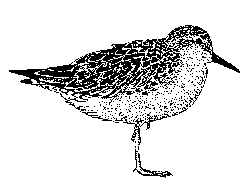David M. Larson
Increasing numbers of studies have shown that global climate change alters phenology of plant and animal communities and is implicated in changes in bird populations and behavior. One potential problem involves reductions in habitat availability, especially for species dependent upon restricted habitats, e.g., loss of salt marshes for Saltmarsh Sparrow. Another set of problems that has been well documented is mismatches between migratory bird movement times and prey availability peaks. Birds have evolved migratory strategies that rely on abundant prey at migratory stopover points and during crucial feeding periods for nestlings. When food resource availability peaks earlier due to altered climatic conditions but bird migration does not or cannot adjust as rapidly, the result can be reduced adult fitness and migration delays. Mismatches between breeding and peak resources on the breeding grounds can lead to increased mortality of hatchlings. But climate-induced effects need not be so obviously direct.

Red Knot by George West
van Gils et al. (2016) recently reported on a three-decade study on Red Knots (Calidris canutus canutus) breeding in the high Arctic on the Taimyr Peninsula in Russia, staging on migration in Gdansk Bay in Poland, and wintering at Banc d’Arguin in the West African country of Mauritania. Based on satellite data, snowmelt on the breeding grounds has occurred progressively earlier over the past 33 years (rate of 0.5 days/year), reflecting the high trends of warming in the Arctic. Over this period, the researchers captured Red Knots and measured body sizes—mass, bill length, tarsus length, and wing chord—of 1990 juveniles during their first autumn migration in Poland. On a year-by-year basis, juveniles were smaller after Arctic summers with early snowmelts, including overall size and bill length. In years with later snowmelts, the juveniles had longer bills and were bigger overall.
Decreasing body size in the juveniles could be due to insufficient nutrition caused by a mismatch between hatching and prey abundance. While adult knots are arriving on the breeding grounds earlier (0.25 days/year), the rate of that change is only half the rate of change in snowmelt dates. The increasing gap between the post-melt prey abundance peak and hatch dates means that the growing chicks cannot take advantage of the normally abundant food. In addition, with earlier snowmelt, the major insect prey items are smaller bodied, making them of lower nutritional value.
These physical disparities in size and bill length were retained when the birds arrived in Mauritania, demonstrating no signs of compensatory growth. It seems that early snowmelt leads to lowered availability of nutritional resources for growing chicks, which leads to permanently stunted offspring.
On the wintering grounds in Africa, the knots feed on mollusks in the intertidal mud flats. Longer-billed birds rely mostly on the abundant and high quality bivalve Loripes lucinalis, whereas shorter-billed individuals do not, possibly because the Loripes are beyond their reach. A bird with a 40mm bill can reach twice as many Loripes as can a bird with a 30mm bill. The short-billed knots feed primarily on the relatively rare bivalve Dosinia isocardia and rhizomes of seagrass. Having a shorter bill consigns birds to a lower-quality diet. Knots with shorter bills have lower apparent survival rates throughout life.
Thus, there is a strong selection pressure against the stunted juvenile Red Knots due to a trophic mismatch caused by earlier snowmelt dates. Due to the higher mortality of short-billed juvenile knots, the bill length of the adult knots is decreasing slower than is the overall body size, suggesting a climate effect on body shape.
While these studies focused on the steeply declining Red Knot subspecies in the Old World, there is no reason not to suspect similar problems with New World knots or many other Arctic-nesting sandpipers. Of course, drawing broad conclusions from these sorts of the analyses is not simple, and effects of other covariates are a constant complication for all descriptive studies of climate change effects.
This work is of critical importance because it stitches together the entire life history of these birds, showing that climate change effects in one part of the world can lead to selection pressures later in life. This sobering reality demonstrates the need for international cooperation in science and bird protection efforts, as in this Science paper involving researchers from the Netherlands, Australia, France, Poland, and Russia.
Reference
- van Gils, J.A., S. Lisovski, T. Lok, W. Meissner, A. Ozarowska, J. de Fouw, E. Rakhimberdiev, M.Y. Soloviev, T. Piersma, and M. Klaassen. 2016. Body Shrinkage Due to Arctic Warming Reduces Red Knot Fitness in Tropical Wintering Range. Science 352 (6287): 819-21.
David M. Larson, PhD, is the Science and Education Coordinator at Mass Audubon’s Joppa Flats Education Center in Newburyport, the Director of Mass Audubon’s Birder’s Certificate Program and the Certificate Program in Bird Ecology (a course for naturalist guides in Belize), a domestic and international tour leader, Vice President of the Nuttall Ornithological Club, and a member of the editorial staff of Bird Observer.